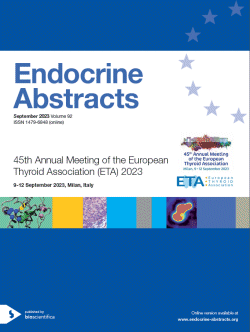
45th Annual Meeting of the European Thyroid Association (ETA) 2023
Poster Presentations
Thyroid Hormone Transport & Metabolism Basic
ea0092ps2-19-01 | Thyroid Hormone Transport & Metabolism Basic | ETA2023
Types 2 and 3 deiodinase are induced in blood cells of critical ill patients: Implications to nonthyroidal illness syndrome pathophysiology
Oliveira Thaliane , Dheher Milla , Braun Andre , Vidart Josi , Marschner Rafael , Kotzian Bruno , Ulian Bruna , Wajner Simone
ea0092ps2-19-02 | Thyroid Hormone Transport & Metabolism Basic | ETA2023
PResence of MCT8 and OATP1C1 in mouse endothelial cells is required for normal brain development and function
Alevyzaki Androniki , Markova Boyka , Mayerl Steffen , Heuer Heike
ea0092ps2-19-03 | Thyroid Hormone Transport & Metabolism Basic | ETA2023
Thyroid hormone metabolite 3-iodothyronamine (T1AM) as an effective repressor of microglia-mediated neuroinflammation
Polini Beatrice , Ricardi Caterina , Carnicelli Vittoria , Rutigliano Grazia , Saponaro Federica , Zucchi Riccardo , Chiellini Grazia
ea0092ps2-19-04 | Thyroid Hormone Transport & Metabolism Basic | ETA2023
Repositioning of cefuroxime as novel selective inhibitor of the thyroid hormone activating enzyme type 2 deiodinase
Miro Caterina , Sagliocchi Serena , Murolo Melania , Gaetana Cicatiello Annunziata , Nappi Annarita , Di Cicco Emery , Torabinejad Sepehr , Dentice Monica
ea0092ps2-19-05 | Thyroid Hormone Transport & Metabolism Basic | ETA2023
Characterization of epcam in thyroid cancer biology by three-dimensional spheroids in vitro model
Ghiandai Viola , Stellaria Grassi Elisa , Fugazzola Laura , Persani Luca
ea0092ps2-19-06 | Thyroid Hormone Transport & Metabolism Basic | ETA2023
DIO2 and dehal1 are common targets of MIR-146B and PAX8 shaping a regulatory circuit that modulates the differentiated phenotype of papillary thyroid carcinomas
Riesco-Eizaguirre Garcilaso , Alonso Chamorro Maria , Aramendia Elena , Santisteban Pilar
ea0092ps2-19-07 | Thyroid Hormone Transport & Metabolism Basic | ETA2023
Absence of MCT8 and OATP1C1 in mouse oligodendroglia cells results in delayed myelination
Richter Joshua-Joel , Markova Boyka , Boelen Anita , Mayerl Steffen , Heuer Heike
ea0092ps2-19-08 | Thyroid Hormone Transport & Metabolism Basic | ETA2023
Thyroglobulin detection in extracellular vesicles isolated from human plasma
Đorić Ilona , Janković Miljuš Jelena , Kosanović Maja , Išić Denčić Tijana , Živaljević Vladan , Selemetjev Sonja



